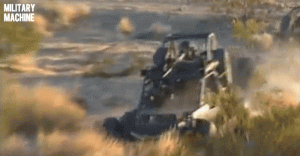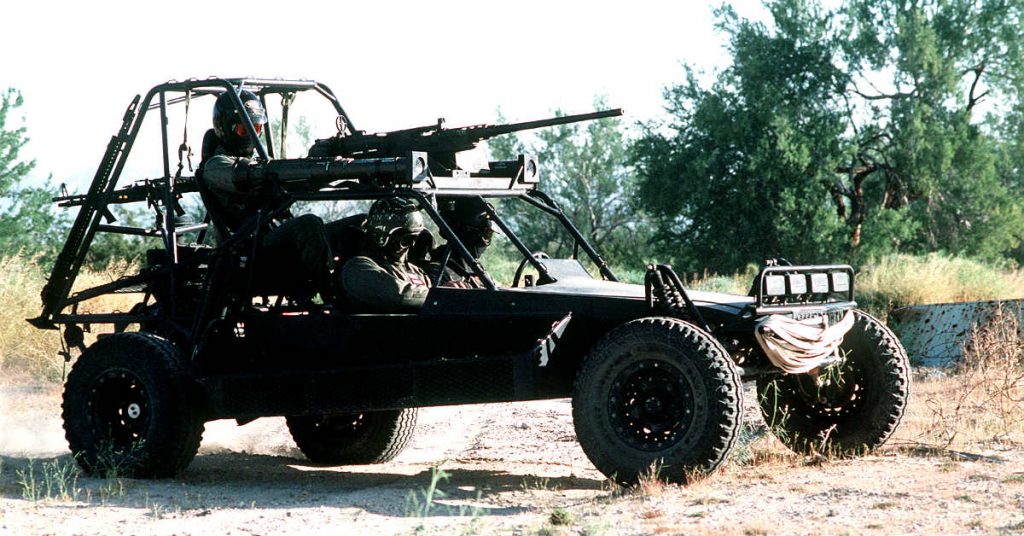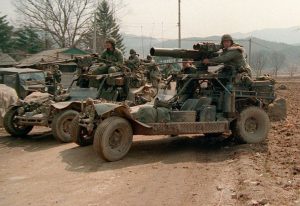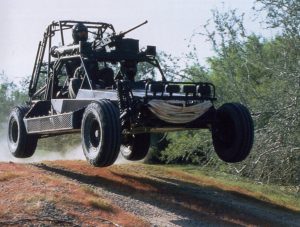Desert Patrol Vehicle By Chenoweth Racing
The Scorpion DPV (Desert Patrol Vehicle), manufactured by Chenoweth Racing Company, is a lightly armored, high speed, dune buggy on steroids. It is used by special operations forces for long range reconnaissance and deep strike missions.
The Desert Patrol Vehicle first saw action in Operation Desert Storm. Then known as the Fast Attack Vehicle, the DPV’s high maneuverability and speed allowed it to race across the desert in advance of conventional vehicles, while avoiding the hastily made obstacles that would have slowed down its conventional counterparts. Navy Seals on Desert Patrol Vehicles were some of the first to enter Kuwait City during the Persian Gulf War.

Origins:
The Desert Patrol Vehicle follows a long line of highly maneuverable desert reconnaissance vehicles. During World War II, the British Army birthed the concept of the Desert Patrol Vehicle with the creation of the Long-Range Desert Group. This group used specially modified military vehicles to perform reconnaissance and intelligence gathering missions in Africa while they tracked down and shadowed the German Army during the Egyptian Campaign.

The DPV is an offshoot of the Fast Attack Vehicle, which originally saw service in the 1980s with the US Army in the 9th Light Infantry Division. Eventually, Special Forces took over the FAV program and, after modification and testing, resulted in the Desert Patrol Vehicle.

Performance:
The Scorpion is a 2×4 off road vehicle. It has a 200 horsepower 2-liter, air cooled VW, although a 100-horsepower diesel is optional. It has a speed upwards of 60 miles per hour and a range of 200 miles. Optional fuel bladders can extend this distance to over 1,000 miles. At 163 inches long and a wheelbase of 113 inches, the Scorpion has a ground clearance of 17 inches. It weighs 2,110 pounds and has a combat payload of 1,540 pounds. It is small and light enough that it can be transported via sling-load in either the CH-47 Chinook or CH-53 Super Stallion.
Desert Patrol Vehicles are highly maneuverable and perfect for rugged off-road travel. They have a ‘trailing-arm’ system that controls the suspension. With two shock absorbers in the front and four in the rear, the 2×4 DPV can travel anywhere a 4×4 would.

Armament:
While the 3-man crew of the Desert Patrol Vehicle carry their assigned personal weapons, the DPV has a variety of weapon mounting capabilities. These mission specific weapons systems include the 40mm SACO MK19 Automatic Grenade Launcher, the .50 caliber M2 Browning Heavy Machine Gun, the 7.62mm M60 General Purpose Machine Gun (and other 7.62mm machine gun platforms), and 2 Anti-Tank Missile Launchers (similar to the TOW missile). The Desert Patrol Vehicle does not come equipped with NBC (Nuclear Biological Chemical) equipment or night vision equipment. However, the crew (mission specific) may have both in a personal capacity.

Use And Service History:
The Desert Patrol Vehicle first saw operational use during Operation Desert Storm. US Navy Seal Teams utilized the DPVs to race across the desert and through urban environments while avoiding obstacles that would hinder the movement of their larger, more conventional vehicular brethren. This allowed special operators to track and surveil Iraqi armor and infantry formations.
Currently, SEAL Team 3 is the primary user of the Desert Patrol Vehicle. Although, other special operations communities like Delta Force have been known to use it as well. It is also believed that Desert Patrol Vehicles were used during both Operation Iraqi Freedom and Operation Enduring Freedom. Americans at home first saw the Desert Patrol Vehicle when the liberation of Kuwait City was televised. Navy Seals in Bedouin head-garb rode the streets in their light, maneuverable DPVs.

